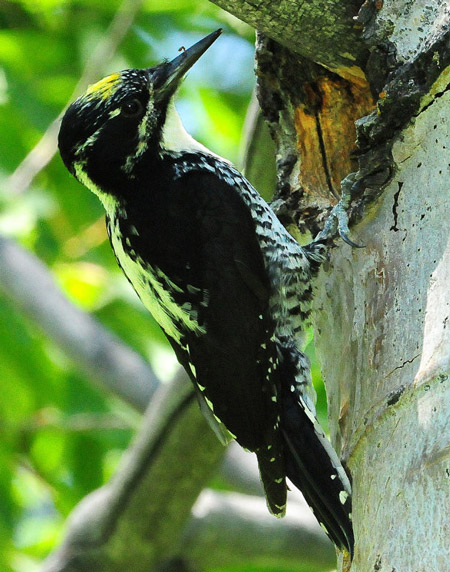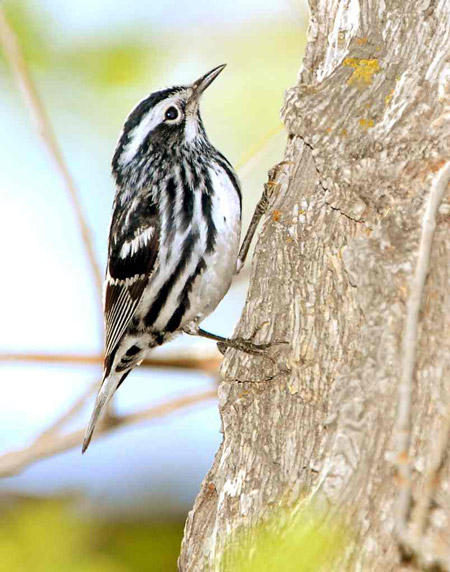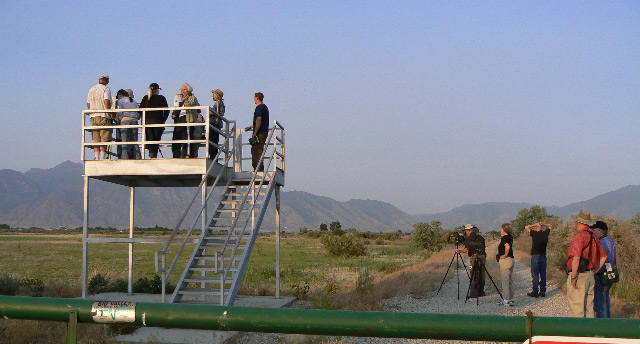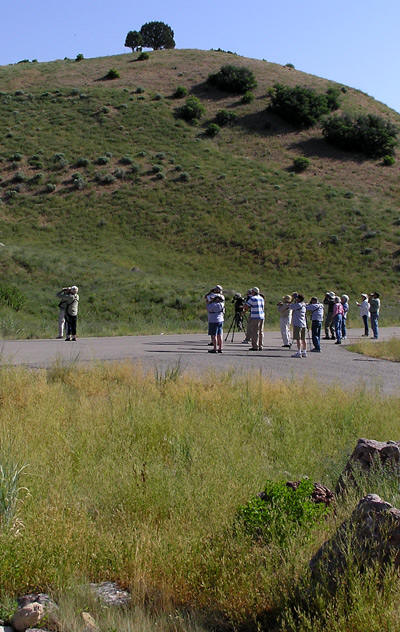Utah County Birders Newsletter
|
 |
|
American Three-toed Woodpecker - photo by Paul Higgins |
Merrill's Musings
By Merrill Webb
Bird Survey
Buck Hollow bird survey, Uinta National Forest. Early morning, July 9, 2008. To
get to point one of the bird survey route was only 1.8 miles from the Lake Creek
Road on the Heber Ranger District. But it took more than 10 minutes to access
it--typical forest service road. Rutted and full of pot holes. I was looking
forward to this particular survey a little more than some of the others I do on
the forest. Had found some "good" birds on the previous counts along this two
mile stretch of road. I remembered the first time: 1994. Point 10 (the last
survey point): Gray Jay, Pine Grosbeak and Three-toed Woodpecker. The Woodpecker
had been working a downed spruce. First time I had ever seen a woodpecker of
this particular species working horizontally on a large tree trunk that had
fallen. Hadn't seen very many 3-toed before that. But I have seen at least two
Three-toed on every successive Buck Hollow count since then. Only transect that
had been so consistently productive for a bird the Uinta considered a management
indicator species (MIS) as well as a sensitive species. Haven't seen a Gray Jay
since, though.
Arrived at point one. Clearing in the aspen forest. While taking temperature and
recording GPS coordinates I could hear birds calling from all directions, and
many different ones, too. Coordinates recorded, time to start the timer: ten
minutes. Writing them down as quickly as possible so as not to miss any: HOWR, ...DEJU, ...BRSP, ...(here?
Wait a minute....where's the sagebrush?) Looking across the road I see a small
patch of sagebrush...okay, Brewer's Sparrow is possible. WAVI,...(of
course, ...they're always here in the aspen forest), PISI, ...(fly over), MOCH, ...(distant,
but chickadee call unmistakable), ...HETH, ....MODO, ....AMRO (ubiquitous),
...CORA, ...WWPE (in the woods where I'm headed next), ...RBNU (nice, always
like to hear the nuthatch), ....BHCO (dang, bad news for some bird, or birds), ...MOBL
(flying across the road, but not calling), RSFL, ....WCSP, ....LISP, ...TRES,
...(flying overhead), RNSA,.. (hmmm, that makes two woodpeckers here), ...YRWA, ...suddenly
a loud 'peek' call followed by a half-second rattle call. And an answer from a
tree nearby--HAWO (two of them--nice, ....three woodpecker species to start off
with). DUFL was the last one to make its's presence known before the ten minutes
were up. Amazing! Twenty-one different species to start the count with.
Hopefully a harbinger of good things yet to see.
Point two. I added two more new ones: RCKI and another sparrow, CHSP. Third stop,
added two more new ones: WETA and two BRCR's, the first time I had heard
creepers this year. Fourth stop, added a RECR. (Good, didn't want to miss that
one even though it was a fly over, and I could barely see the red color). At
stop #5, no new ones, but did chase down and add another Hairy. Point #6, no new
ones, but added another crossbill and another Hairy. Point #7, a good one
(another woodpecker), and first time on this count: a Williamson's
Sapsucker...'nice find, Webb', I thought. Next stop would prove to be even
better: two TTWO's (that made five woodpeckers, so far),...and...two
White-winged Crossbills calling way up in a dead snag. So rare that the code for
this species isn't even on my list of bird names. The first time on any of my 48
two mile routes. And, I had seen two the day before on my twenty-five mile BBS
route along the Duchesne Ridge. Pretty amazing. Nothing new at point #9. Point
10, added one more new species for the day: Gray Jay. After totaling them all up
I ended with 31 species compared with the 32 I had seen two years previous. Most
numerous was the American Robin (19) followed by the Yellow-rumped Warbler (13)
and Dark-eyed Junco (10). Five woodpeckers in one day was pretty good, too.
And so ended another day in the forest. All alone with nobody to share the
excitement with. Hence, this report.
UCB President, Merrill Web
 |
|
Black-and-white Warbler - photo by Paul Higgins |
Bird of the Month
Black-and-white Warbler
Mniotilta varia
by Cheryl Peterson
It was very difficult to decide which bird to choose for bird of the month.
Since it is migration time, I thought it would be fun to highlight a bird that
we only get to see as it passes through Utah on its way to either its breeding
or wintering grounds. I changed my mind several times, then finally settled on
the Black and White Warbler.
The Black and White Warbler is a common bird and breeds in Canada and the
eastern United States. It winters from the southern United States to northern
South America. It is a rare migrant in Utah.
This warbler is easy to identify because of its black and white plumage. It is about 5 inches long, has a long thin black bill and black legs. It has a long
hind toe and claw on each foot to help it move easily along branches. The male
has a black crown, cheek and throat (throat white in fall and winter) and white
flanks with black streaks. The female has a white throat, grayish cheeks and buffy flanks with black streaks. The juveniles look similar to the female.
The Black and White Warbler forages for insects while creeping along the trunks
and branches of trees, much like a nuthatch. Its old name is Black and White
Creeper. It eats caterpillars, adult insects and spiders. In the winter, it will
eat dormant insects and fruit.
I was surprised to learn that it nests on the ground with the nest being built
close to the trunk of a tree or bush, or next to a log. The female usually lays
5 eggs and incubates them without the help of the male. Incubation lasts about
10 or 12 days and the young leave the nest 8 to 12 days after hatching. At that
point, they are still unable to fly.
Cornell describes the song as a series of very high, two-syllable phrases,
resembling the sound of a squeaky wheel; "wee-see-wee-see-wee-see." Others have
described it as the sound a cloth makes when you repeatedly wipe it across a
window pane. The call note is a sharp chip.
I have seen Black and White Warblers on River Lane (Utah County) in the fall and
at Garr Ranch in both spring and fall. I will be watching to see where they are
reported this fall.
My sources for information were Warblers (Peterson Field Guide), Utah Department
of Wildlife Resources, Cornell Lab of Ornithology and Whatbird.com.
 |
|
UCB at 4000 West - July 10, 2008 - photo by Lynn Garner |
4000 West - Lincoln Beach - 10 July 2008
by Eric Huish
Several carloads of birders met at the Sam's club parking lot for an
evening field trip to Utah Lake led by Merrill Webb. Our main stop was the viewing tower on 4000
West, Lakeshore, where there were nesting osprey and many birds out in the
marshes. We stood on the viewing tower and scoped out Gadwall, Cinnamon Teal,
White-faced Ibis, American Avocet, Greater Yellowlegs, Lesser Yellowlegs,
Willet, Marbled Godwit, Wilson's Snipe, Wilson's Phalarope, Franklin's Gull and
more. Other birds along 4000 West included: Eastern Kingbird, Song Sparrows and
singing Common Yellowthroats (heard only).
We then headed to Lincoln Beach where we were able to get good views of a few
Snowy Plovers and a Spotted Sandpiper. With the sun low on the horizon and
distant wildfires clouding the sky, the light was spectacular. A Great Blue
Heron flying out over the lake, Caspian Terns, flock after flock of White-faced
Ibis and a Black-crowned Night-Heron seemed to glow against the sky as they
passed over. Evening is a great time to bird.
Here's a list of the birds we saw, or heard (Compiled by Merrill Webb): Canada
Goose, Gadwall, Mallard, Cinnamon Teal, Ring-necked Pheasant, Am. White Pelican,
Great Blue Heron, Black-crowned Night-Heron, White-faced Ibis, Sandhill Crane,
Snowy Plover, Killdeer, American Avocet, Greater Yellowlegs, Lesser Yellowlegs,
Willet, Spotted Sandpiper, Marbled Godwit, Wilson's Snipe, Wilson's Phalarope,
Franklin's Gull, California Gull, Caspian Tern, Mourning Dove, Western Kingbird,
Eastern Kingbird, Tree Swallow, N. Rough-winged Swallow, Bank Swallow, Cliff
Swallow, Starling, Common Yellowthroat, Song Sparrow, Red-winged Blackbird,
Western Meadowlark, Yellow-headed Blackbird, Great-tailed Grackle, Bullock's
Oriole. A total of 38 species.
 |
|
Birding in Diamond Fork Canyon - July 19, 2008 - photo by Eric Huish |
Diamond Fork Canyon -
19 July 2008
by Merrill Webb
The week-end fieldtrip for July was led by Merrill Webb to Diamond Fork, a
canyon and stream located about eleven miles east of the city of Spanish Fork in
Utah County. Twenty-two birders arrived in the canyon about 7:30 AM and spent
the next four hours stopping along the road at various pull-outs looking for
resident birds. Some time was also spent at Diamond Campground although it
wasn't as productive in terms of bird species, probably due to the lateness of
the morning and the presence of many people occupying the various campsites. A
trip list (consisting of birds observed at the parking lot in Provo, and along
the highway to Diamond Fork as well) of approximately 50 species resulted from
our surveying the riparian and hillside habitats even though not every person
saw all species. Favorite birds included good looks at a Common Nighthawk
perched horizontally on a tree limb, an adult Golden Eagle perched in a tree
across the stream, a handsome male Black-headed Grosbeak within good viewing
distance and a cooperative Willow Flycatcher. But the best bird occurred as
everyone was preparing to leave the canyon. We had attempted to find the Black
Phoebe that had been seen a couple of weeks earlier, with only four people
getting good looks at one for just a brief moment as we entered the campground.
This one did not cooperate, however, so after waiting for about twenty minutes
we continued on to other areas with the plan to try again on the way back down
the canyon after lunch. Fortunately, the phoebe was there for all to see, plus
it was joined by a second; so, possibly a mated pair. This would be a new Utah
State record for a successful nesting this far north. Somebody needs to check
back in a couple of days to see if there are any juvenile birds flying around.
Participants included Yvonne and Bart Carter, Bob and Marilyn Parsons, Steve and
Cindy Summerfeld, Eric Huish, Tuula Rose, Lara Goldie, Ned Bixler, Kathy Knaus,
Leila Ogden, Carol Nelson, Alona Huffaker, Junese Markham, Flora Duncan, and
daughter Esther; Bobbie Davis, Jason Lane, Paul Lombardi and Stephen Carlile.
Bird list (in addition to those already mentioned above): Mallard, Northern
Harrier, Swainson's (I-15) and Red-tailed Hawks, American Kestrel, American
Coot, Mourning Dove, Broad-tailed Hummingbird, Belted Kingfisher, Red-naped
Sapsucker, Downy Woodpecker, Northern Flicker, Western Wood-Pewee (heard)
Western Kingbird, Western Scrub-Jay, Black-billed Magpie, Common Raven, Tree,
Violet-green, Rough-winged, Cliff and Barn Swallows; Black-capped Chickadee,
Rock and House Wrens; Mountain Bluebird, American Robin, Gray Catbird, Starling,
Cedar Waxwing, Yellow Warbler, Spotted Towhee, Chipping, Lark, and Song
Sparrows; Fox Sparrow (heard), Lazuli Bunting, Red-winged Blackbird, Western
Meadowlark, Brewer's Blackbird, Great-tailed Grackle (Provo), Brown-headed
Cowbird, Bullock's Oriole, House Finch, Lesser, and American Goldfinchs.
Thanks to all who participated.
Backyard Bird of the
Month
July 2008
Steve Carr - Holladay
Black-capped Chickadee - Several parents showing all the chicks how to
use the various feeders.
Yvonne Carter - Highland
I think the Northern Flickers might be back.
Eric Huish - Pleasant Grove
Rufous Hummingbird - a bright orange male.
Milt Moody - Provo
Black-headed Grosbeak and young.
LeIla Ogden - Orem
The things sitting at my feeders are CATS not birds. Can't get rid of them.
Reed Stone - Provo
Black-headed Grosbeaks - several wait their turn to feed at my
discriminating black oil sunflower seed feeder.
Alton Thygerson - Provo
Rufous Hummingbird - this is a little bully bird for it drives off the
other hummingbirds.
Bonnie Williams - Mapleton
Western Scrub-Jay - I never get tried of seeing them.
We would like you to share your favorite backyard bird each month. Please send
your favorite bird at the end of the month to newsletter@utahbirds.org or call
360-8777.